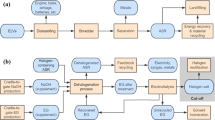Abstract
Automobile shredder residue (ASR) generated by end-of-life vehicles, comprises more than 20% of a new vehicle by weight. Significant amounts of polymers in ASR, such as Poly Propylene (PP), Poly Ethylene (PE), Acrylonitrile Butadiene Styrene (ABS), Ethylene Propylene Ethylidene Nobomene (EPDM), rubber, Polyethylene Terephthalate (PET), Poly Amide (PA), and Poly Vinyl Chloride (PVC), can be used as energy or chemical sources, whereas other components, such as tires, rubber, glass, wood, sand/dust, and heavy metals inhibit the recycling of ASR. In many countries, landfill use of ASR is regulated, so landfill costs have increased, as has inappropriate disposal; sending ASR to landfills will be needed to be regulated in Korea. Pyrolysis has been suggested as an economically feasible recycling and recovery technique for ASR in Korea and other advanced countries. Before such technology is implemented, the characteristics of pyrolyzed products should be investigated. Shredded samples from the facility were collected, and calorific value, elemental analysis, and leaching tests were performed to determine ASR characteristics. Pyrolysis experiments were conducted at five different temperatures, 400, 500, 600, 700, and 800 °C, and the product distributions of gas, tar, and char were investigated. The optimal temperature for ASR pyrolysis, in terms of yield efficiency, was found to be 600 °C. The mean calorific value was also found to be higher in this case; thus, ASR can be treated as an auxiliary fuel. During pyrolysis, there were high ignition losses of light and heavy fluff, due to the presence of organic materials. The leaching concentrations of all tested heavy metals were found to be within the Korean guideline values. In terms of carbon number distributions, pyrolysis of ASR at 600 °C was optimal. For further utilization of pyrolysis products as fuel, the characteristics of char, oil, and gas were investigated with an experimental batch reactor.
Similar content being viewed by others
References
KAMA, Available from 〈www.kasa.or.kr/bbs_board_file/statistics/statistics list.asp〉, Seoul, Korea (2003).
BMW, BMW Environmental Report, 1997/98–2000 (2000).
Japan Automobile Manufacturers Association (JAMA), Strategy of Recycling ELVs, JAMA Report, Tokyo, Japan (1999).
Anonymous, Recycling and the Automobile, Automotive Engineering, 41–57, October (1992).
D. Lanoir, G. Trouve, L. Delfosse, D. Froelich and A. Kassamaly, Waste Management Res., 15, 267 (1997).
C. H. Lee, Research Conservation and Recycling, 20, 207 (1997).
S. Das, T. R. Curlee, C. G. Rizy and S. M. Schexnayder, Resources Conservation and Recycling, 14, 265 (1995).
M. Day, J. D. Cooney and Z. Shen, J. Anal. Appl. Pyrolysis, 37, 49 (1996).
M. Day, J. Graham, R. Lachmansingh and E. Chen, Resources Conversation and Recycling, 9, 255 (1993).
M. Day, Z. Shen and J. D. Cooney, J. Anal. Appl. Pyrolysis, 51, 181 (1999).
EU, Directive of European Parliament and of the Council, 2000/53/EC (2000).
R. Voyer, Technico-economic and environmental study of the processes for the treatment of residues from the salvaging of cars, Centre de Recherche Industriel Du Quebec, Report VPOIT-91-098, 739-PE02996, April (1992).
C. Roy and A. Chaala, Resources Conservation and Recycling, 32, 1 (2001).
R. Rausa and P. Pollesel, J. Anal. Appl. Pyrolysis, 40–41, 383 (1997).
S. Galvagno, F. Fortuna, G. Cornacchia, S. Casu, T. Coppola and V. K. Sharma, Energy Conversation and Management, 42, 573 (2001).
K. Motohiro, H. Michiko, Y. Masataka and M. Shigekatsu, Technical Notes Society of Automotive Engineers of Japan (JSAE) Review, 22, 221 (2001).
Ministry of Environment, Bulletin of The Ministry of Environment, 2000-41 (2000).
USEPA, Test Method for Evaluating Solid Waste Physical/Chemical Method, SW-846, method 3050B (1998).
J. L. Sullivan, R. L. Williams, S. Yester, E. Cobas-Flores, S. T. Chubbs and S. G. Hentges, Life cycle inventory of a generic U.S. family-Sedan Overview of Results USCAR AMP Project. SAE Paper #982160, Detroit, MI: Society of Automotive Engineers (SAE), (1998).
K. H. Kim, H. T. Joung, H. Nam, Y. C. Seo, J. H. Hong, T. W. Yoo and B. S. Lim, Waste Management, 24, 533 (2004).
B. Boughton and A. Horvath, Resources Conservation and Recycling, 47, 1 (2006).
G. Winslow, Advanced separation of plastics from shredder residue, SAE 2004-01-0469 (2004).
C. Keller, Optimized disposal of automotive shredder residue. In: Ludwig C, Hellweg S, Stucki S, editors. Municipal solid waste management-strategies and technologies for sustainable solutions. Heidelberg, Germany: Springer-Verlag, 294–307 (2003).
W. S. Hubble, I. G. Most and M. R. Wolman, Investigation of the energy value of automobile shredder residue, U.S. Department of Energy Report, DOE/ID12551, August (1997).
H. T. Joung, K. H. Kim, H. Nam, Y. R. Kim, J. H. Hong, T. W. Yoo, J. H. Park and Y. C. Seo, J. Korea Society of Waste Management, 20, 415 (2003).
R. J. Schmitt, Automobile shredder residue — the problem and potential solution, CMP Report #90-1, Centre for Material Production, Pittsburgh, PA (1990).
Author information
Authors and Affiliations
Corresponding author
Rights and permissions
About this article
Cite this article
Joung, H.T., Seo, Y.C., Kim, K.H. et al. Distribution and characteristics of pyrolysis products from automobile shredder residue using an experimental semi-batch reactor. Korean J. Chem. Eng. 24, 996–1002 (2007). https://doi.org/10.1007/s11814-007-0110-y
Received:
Accepted:
Published:
Issue Date:
DOI: https://doi.org/10.1007/s11814-007-0110-y




